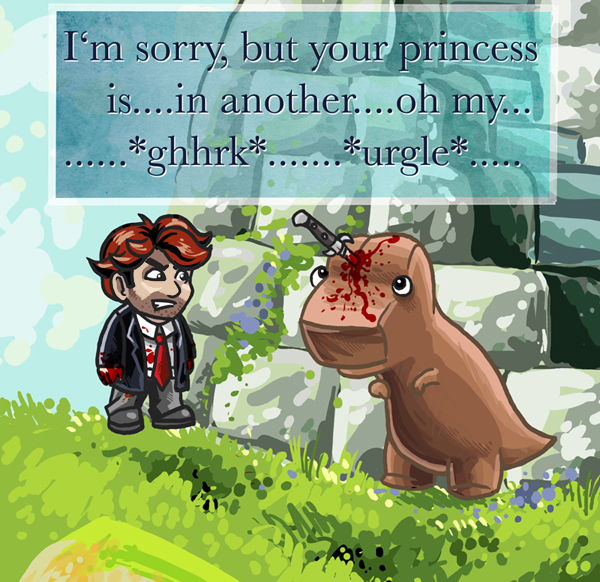This is probably the single biggest issue me and my friend had when we started making the case, with the quite obvious dilemma that, at certain points in the game, the ‘Princess’ is referred to in a variety of different situations, all differing in tone and meaning. Take one of the pre-world books from ‘Time and Mastery’ for example;
3. Time and Mastery
All those years ago, Tim had left the Princess behind, He had kissed her on the neck, picked up his travel bag, and walked out the door. He regrets this, to a degree. Now he’s journeying to find her again, to show he knows how said it was, but also to tell her how it was good.
Doesn’t sound much like the researching and testing of an atomic bomb, right? The problem is, no single depiction of the Princess works in the way you’ve described. While the post that I wrote does draw a lot of its evidence from the epilogue texts, there are instances in the main game that support either the reading of the Princess as something of a multiple metaphor, the presence of a female character openly referred to as being someone other than the Princess, or both these things. Take Time and Decision;
5. Time and Decision
She never understood the impulses that drove him, never quite felt the intensity that, over time, chiselled lines into his face. She was never quite close enough to him – but he held her as though she were, whispered into her ear words that only a soul mate should receive.
Over the remnants of dinner, they both knew the time had come. He would have said: “ I have to go find the Princess,” but he didn’t need to. Giving a final kiss, hoisting a travel bag to his shoulder, he walked out the door.
Through all the nights that followed, she still loved him as though he had stayed, to comfort her and protect her, Princess be damned.
What can be said for both these blocks of text however, is the relation they share in the event of the Tim leaving – note the mention of the travel bag in both sections, which is either clumsy writing (which I doubt) in that two different separations are being described so similarly, or not a coincidence at all, with the same event being mentioned twice, once as it’s happening and again from a future perspective. It’s this that I think gives us grounds to take the interpretation of the Princess as different things in different instances; he left the Princess behind in the first passage in the terms of a relationship, and refers to the Princess in the second as the focus of his dedicated voyage, despite the female presence remaining outside of this. After that section in Time and Mastery, as well as two other instances;
For a long time, he though they had been cultivating the perfect relationship. He had been fiercely protective, reversing his mistakes so they would not touch her.
4. Time and Place
This improvement, day by day, takes him ever-closer to finding the Princess. If she exists – she must! – she will transform him, and everyone.
6. Hesitance
Perhaps in a perfect world, the ring would be a symbol of happiness, It’s a sign of ceaseless devotion: even if he will never find the Princess, he will always be trying. He still will wear the ring.
These all sound more adaptable to what my friend and me outlined. The idea of a man so devoted to a single cause that he will revert any mistakes possible so as to keep the object of his focus out of the hands of others, of people who may wish to take it away from him.
But as I said, these are just the pieces that correlate with a lot of what’s contained within the epilogue. My argument is that there’s simply too much contained in the epilogue books too ignore; things like the quotations from Lifton and Bainbridge would seem like very odd things to throw in for just a single piece of text on a single screen. The correlations these have with the books leading up to it throughout the game are the ones I wanted to focus on, and I think that they can be made without risking shoehorning. Even the little things, like the "Your Country Needs You" WWII era poster shown in the World 5 painting, go some way to linking these two elements.
Also, as I stated at the started of the post that I wrote, the splitting of the female passage into three distinct voices, at three different times allows for the ‘Braid’ theory in the first place – that of three separate strands interwoven to make one distinctive pattern. The Princess as bomb, and the Princess as spurned partner could work through this (just don’t ask me for the third… we hear the story of the child looking through the candy store window, but his guardian is never alluded to as fitting the Princess role).



